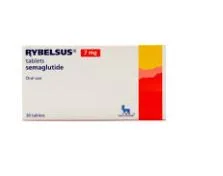Rybelsus Explained: A Comprehensive Guide for Patients and Caregivers
Understanding a new medication can feel overwhelming for both patients and caregivers. In this comprehensive guide, we will walk you through Rybelsus in clear, practical language: what it is, how it works, how to use it safely, and what to watch for. We will also briefly compare it with other medications such as Mounjaro, Ozempic, and discuss how medication regimens may intersect with drugs like Paracodine syrup or Adderall. This article is for informational purposes only and is not a substitute for medical advice.
What is Rybelsus?
Rybelsus is the brand name for the oral form of semaglutide, a drug in the class of GLP-1 receptor agonists. It is used as an adjunct to diet and exercise to improve blood sugar control in adults with type 2 diabetes. It is not intended for type 1 diabetes. Rybelsus is taken once daily and is designed to help manage blood sugar alongside lifestyle measures such as diet and physical activity. For patients and caregivers, the key aspects are proper administration, expected benefits, side effects, and how it fits into an overall care plan.
How Rybelsus Works
Rybelsus works by mimicking a naturally occurring hormone called GLP-1. This hormone helps the body release insulin when blood sugar is elevated, slows stomach emptying to prevent rapid spikes in glucose, and reduces sugar production in the liver in some cases. These actions smooth out blood sugar fluctuations, improve overall glycemic control, and may help reduce appetite, though Rybelsus is not specifically approved for weight loss.
Using Rybelsus: Timing, Dosage, and Administration
Proper use of Rybelsus is crucial for effectiveness. Take the tablet first thing in the morning on an empty stomach with plain water only. After taking it, wait at least 30 minutes before eating, drinking anything other than water, or taking other oral medications. Swallow the tablet whole; do not split, crush, or chew it. The starting dose is usually 3 mg once daily for the first 30 days to help your body adjust. After this, the dose is typically increased to 7 mg once daily if tolerated and more blood sugar control is needed. In some cases, the dose may increase further to 14 mg once daily. If a dose is missed, skip it and resume the next day; do not double up. Switching formulations should only be done under a healthcare provider’s guidance.
Benefits of Rybelsus
When used correctly, Rybelsus can lower HbA1C, improve fasting and post-meal glucose levels, support lifestyle efforts such as diet and exercise, and in some patients, assist with modest weight loss. Full effects build over weeks, and the starting dose may not immediately produce significant blood sugar control. Patients and caregivers should maintain realistic expectations and monitor progress with the healthcare team.
Risks, Side Effects, and Precautions
Common side effects of Rybelsus include nausea, vomiting, diarrhea, decreased appetite, abdominal pain, and constipation, especially during the initial dose or dose escalation period. Serious risks include the potential for thyroid C-cell tumors in patients with a history of medullary thyroid carcinoma or multiple endocrine neoplasia type 2, pancreatitis, worsening of diabetic retinopathy in those with pre-existing eye conditions, and the need for careful monitoring in kidney disease if gastrointestinal side effects cause dehydration. Always inform your healthcare provider of all other medications, including Paracodine syrup or Adderall, as these may indirectly affect blood sugar, appetite, or metabolism. Be alert for signs such as a neck lump, difficulty swallowing, severe abdominal pain, or sudden vision changes. Staying hydrated is critical if gastrointestinal side effects occur.
Practical Tips for Patients and Caregivers
Establish a morning routine to take Rybelsus immediately after waking and wait 30 minutes before eating or taking other medications. Use only plain water with the tablet. Keep a diary to track side effects such as nausea, appetite changes, or hypoglycemia. Remember that Rybelsus supports diet and exercise; it is not a replacement for lifestyle changes. Periodically review all medications with your healthcare provider, including Paracodine syrup and Adderall, to avoid indirect effects on blood sugar or appetite. If a dose is missed, skip it and continue with the next scheduled dose. Store tablets in their original blister packaging in a dry, room-temperature environment. Communication between the patient, caregiver, and healthcare team is critical to monitor symptoms and adjust care as needed.
Comparing Rybelsus with Other Medications
Rybelsus vs Ozempic: Both contain semaglutide but differ in administration. Ozempic is a once-weekly injectable, while Rybelsus is a daily oral tablet. Ozempic may also reduce cardiovascular risk in some patients, which Rybelsus does not.
Rybelsus vs Mounjaro: Mounjaro (tirzepatide) is a once-weekly injection that has shown weight-loss effects in addition to blood sugar control. Rybelsus is oral and daily, suitable for those who prefer tablets over injections.
Interplay with other medications: While Rybelsus does not directly interact with all drugs, medications like Paracodine syrup may affect appetite or metabolism, indirectly influencing blood sugar control. Adderall may increase heart rate, decrease appetite, or cause weight changes that require monitoring alongside Rybelsus. Full disclosure of all medications ensures safe and effective treatment.
Role of Caregivers
Caregivers play a key role in supporting patients on Rybelsus. They can help ensure adherence to the morning routine, track side effects and symptoms, encourage diet and exercise, review all medications including Paracodine syrup or Adderall, and communicate with healthcare providers regarding severe symptoms such as dehydration, pancreatitis, or thyroid concerns. Caregivers also provide emotional support and help patients manage expectations as treatment progresses.
Summary and Key Takeaways
Rybelsus is an oral, once-daily tablet for type 2 diabetes that works by improving blood sugar control through insulin stimulation, slower stomach emptying, and reduced sugar production in the liver. Correct timing and administration are critical. Benefits include improved blood sugar levels, and modest weight loss may occur in some patients. Risks include gastrointestinal side effects, thyroid tumors in susceptible patients, pancreatitis, and hypoglycemia when combined with other medications. Caregivers are essential in ensuring adherence, monitoring, lifestyle support, and coordination with the healthcare team. Comparing Rybelsus with Ozempic and Mounjaro highlights differences in administration, convenience, and secondary benefits. Full disclosure of all medications, including Paracodine syrup and Adderall, helps prevent complications and allows healthcare providers to optimize therapy.





